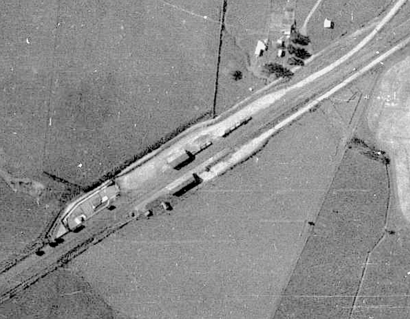Greatford railway station facts for kids
Quick facts for kids
Greatford railway station
|
|||||||||||
|---|---|---|---|---|---|---|---|---|---|---|---|

Greatford railway station in 1942
|
|||||||||||
| Location | New Zealand | ||||||||||
| Coordinates | 40°07′31″S 175°24′56″E / 40.125396°S 175.415496°E | ||||||||||
| Elevation | 105 m (344 ft) | ||||||||||
| Line(s) | North Island Main Trunk | ||||||||||
| Distance | Wellington 176.01 km (109.37 mi) | ||||||||||
| History | |||||||||||
| Opened | 20 May 1878 | ||||||||||
| Closed | 27 March 1983 | ||||||||||
| Rebuilt | 11 June 1939 400 m (1,300 ft) north-westwards |
||||||||||
| Electrified | June 1988 | ||||||||||
| Services | |||||||||||
|
|||||||||||
Greatford railway station was an important stop on the North Island Main Trunk (NIMT) railway line in New Zealand. It was located south of Marton in the Manawatū-Whanganui region. Today, the station is no longer there, but a power substation and a passing loop (a section of track where trains can wait for others to pass) still remain.
Contents
History of Greatford Station
Station Opening and Early Days
The Greatford railway station officially opened on 20 May 1878. This was a big moment because it completed the railway link between the ports of Foxton and Whanganui. Special trains even ran to Marton to celebrate the opening!
In the early days, trains used special engines like the Fairlie, E, and R Class. These trains were quite fast for their time, reaching speeds of about 64 kilometres per hour (40 mph). The Greatford station later became a regular stop for express trains traveling between Wellington and New Plymouth.
Moving the Station
Over time, railway engineers wanted to make the train line smoother and safer. So, on 11 June 1939, the Greatford station was moved about 400 metres (440 yards) to the north-west. This move helped to straighten a curve and make the track less steep between Greatford and Kakariki. It also removed two level crossings, making the area safer for everyone.
Station Activity and Traffic
Greatford station was a busy place, especially in its early years. It sold thousands of tickets to passengers each year. For example, in 1912, over 6,000 tickets were sold! The station also handled a lot of goods, including many sheep and pigs.
Because of all the activity, people even asked to set up refreshment stands to sell tea and coffee to travelers. The station had a stationmaster and a clerk to help manage everything.
Greatford Village and Nearby Areas
Even though Greatford was a small village, the station served larger areas and important people. For instance, it was used by people from big estates like Westoe, which belonged to William Fox, a former prime minister of New Zealand. The station also served as the main rail link for the town of Bulls.
There were plans to build a railway line directly to Bulls from Greatford, and even a longer line from Levin that would bypass Palmerston North. These plans were discussed for many years, but they were never built.
Gravel Pit Operations
Near Greatford, there was a gravel pit that supplied materials for the railway line. From about 1915, a special siding (a short track) was built to connect the pit to the main railway line. This gravel was important for building and maintaining the tracks.
Station Buildings and Facilities
When Greatford station first opened, it didn't even have a waiting room! But soon after, proper station buildings were constructed. The station grew over the years to include:
- A passenger platform
- A goods shed for storing items
- Yards for cattle and sheep
- A water supply
- A stationmaster's house
- A passing loop for trains to pass each other
In 1887, a telephone was installed, replacing the older Morse telegraph. Sadly, in 1917, the goods shed burned down. For many years, from 1878 to 1968, there was even a Post Office located at the station, making it a central hub for the community.
Station Closure
As time went on, fewer people and goods used the railway station. The sheep yards were reduced in 1966 and then completely closed in 1972. By 1980, only a high loading bank and a loop for trains remained. Finally, on Sunday, 27 March 1983, Greatford railway station closed its doors to all traffic.
Images for kids

